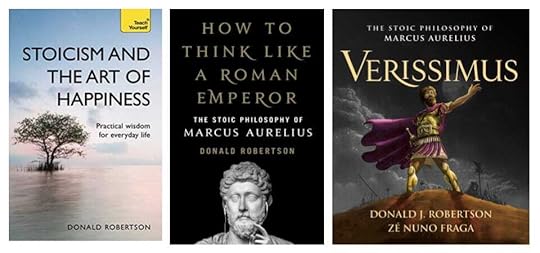Recommended Reading on Stoicism
I often get asked “What should I read first?” by people who are getting into Stoic philosophy. Obviously, it depends. Are you talking about classics or modern books?Are you looking for in-depth academic texts or easy-to-read self-help guides? There are many books available now. Some are much better than others. (Most are okay but one or two are not worth reading.) My own books on Stoicism include Stoicism and the Art of Happiness, How to Think Like a Roman Emperor, and Verissimus: The Stoic Philosophy of Marcus Aurelius.

This guide consists of the other books on Stoicism, which I would recommend. I’ve tried to keep it simple by listing a handful that I think generally provide a good place to start, with some notes on why I’ve included them. Please comment below with your own favourites, and any you think I may have overlooked.
Stoicism: Philosophy as a Way of Life is a reader-supported publication. To receive new posts and support my work, consider becoming a free or paid subscriber.
Modern BooksThe Daily Stoic (2016) by Ryan Holiday and Stephen HanselmanThe Daily Stoic: 366 Meditations on Wisdom, Perseverance, and the Art of Living is the best selling modern book on Stoicism. It contains an extensive selection of original translations from the ancient Stoic texts, with a modern commentary. So, actually, it could be in both ancient and modern categories here. Holiday’s The Obstacle Is the Way: The Timeless Art of Turning Trials into Triumph (2014) is another bestseller worth reading, although he describes it more as a book inspired by Stoicism than an introduction to the philosophy.
How to be a Stoic (2017) by Massimo PigliucciIn How to Be a Stoic: Using Ancient Philosophy to Live a Modern Life, Prof. Pigliucci shows that Stoicism can provide a philosophy of life consistent with a modern scientific worldview, and with atheism or agnosticism as well as different forms of religion. He provides many examples of everyday situations in which he found Stoic philosophy helpful in his own life, and he also draws upon many examples from the lives of others to show how Stoic attitudes and behaviours can contribute to a more fulfilled and emotionally resilient way of living.
Lessons in Stoicism (2019) by John SellarsLessons in Stoicism: What Ancient Philosophers Teach Us About How to Live is a concise introduction to the philosophy, less than a hundred pages. Dr. Sellars is one of the leading academic experts on the subject, and the current chair of the Modern Stoicism nonprofit organization. This is a quick read which helps to clear up some common misconceptions about Stoic philosophy.
A Guide to the Good Life (2008) by William B. IrvineA Guide to the Good Life: The Ancient Art of Stoic Joy was the first modern bestseller on Stoicism. It’s easy to read and has a practical focus, although Prof. Irvine says he’s talking about a modified version of Stoicism that differs from ancient Stoicism insofar as it is more focused on the goal of tranquillity (ataraxia) than virtue (arete). “The resulting version of Stoicism, although derived from the ancient Stoics,” he says “is therefore unlike the Stoicism advocated by any particular Stoic.” Many people find this a more practical approach, though.
Stoicism: A Very Short Introduction (2018) by Brad InwoodThis is perhaps the most academic text on the list but it’s quite easy to read, and very concise, at just over 100 pages. Prof. Inwood is one of the leading modern scholars of Hellenistic philosophy so his description of ancient Stoicism can be considered authoritative — it’s certainly much more reliable than many of the Stoicism books and articles you’ll find online.
Stoic Wisdom (2021) by Nancy ShermanStoic Wisdom: Ancient Lessons for Modern Resilience provides another great introduction by an academic. Prof. Sherman was formerly the chair of ethics at the US Naval Academy and brings a military perspective, including a valuable philosophical discussion of PTSD and moral injury.
Wise Up (2022) by Karen DuffyWise Up: Irreverent Enlightenment from a Mother Who's Been Through It is perhaps the most “fun” read in this list. Karen “Duff” Duffy is a former MTV presenter, model, and film actor, who turned to Stoicism as a way of coping with chronic pain and illness. Duff has a very humorous, down-to-earth, and engaging way of writing, which makes it essay to see how Stoic wisdom could help in everyday life, even when we’re faced with very challenging situations.
 These books don’t exist anymore!Translations of Ancient Books
These books don’t exist anymore!Translations of Ancient BooksMany old translations are now in the public domain. These are often available free online or in cheap printed editions. However, modern readers tend to prefer modern translations, which they may find easier to understand.
The Discourses of EpictetusDiscourses, Fragments, Handbook (2014), translated by Robin Hard with an introduction by Christopher Gill, is a good modern translation.
The Meditations of Marcus AureliusMeditations: A New Translation (2003), translated by Gregory Hays, is the most popular modern translation. I prefer the more recent Meditations: The Annotated Edition (2021) by Robin Waterfield, though.
The Moral Letters of SenecaLetters on Ethics: To Lucilius (2017), translated by Margaret Graver and A.A. Long, is a good modern translation.
Thank you for reading Stoicism: Philosophy as a Way of Life. This post is public so feel free to share it.
Extra ReadingPierre Hadot’s books Philosophy as a Way of Life, What is Ancient Philosophy?, and The Inner Citadel, are among my favourites and although written by a highly-regarded academic they’re quite easy to read.
A.A.Long’s Epictetus: A Stoic and Socratic Guide to Life is an academic analysis of the Discourses of Epictetus, which does for Epictetus what Hadot’s The Inner Citadel does for Marcus Aurelius.
James Stockdale’s Thoughts of a Philosophical Fighter Pilot is a popular collection of essays on Stoicism by a former vice admiral in the US Navy, who was captured by the North Vietnamese at the start of the Vietnam War. Stockdale used Stoic philosophy to survive being incarcerated and tortured.
What have I missed? Please add your comments below. Thanks!



